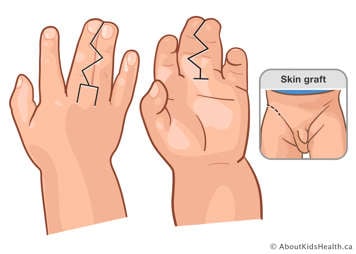Your child has been diagnosed with syndactyly of the hands and recommended surgery. The information on this page describes the surgical options for separating the fingers, the risks of the procedure, and how to take care of your child at home after the surgery.
Surgery
Surgery for syndactyly of the hands involves separating the fingers that are fused together. Part of the procedure will also require extra skin to be added to the separated fingers. A skin graft is the most common way to add extra skin. It is a piece of skin taken from one area of the body and moved to another; this skin then needs to heal in its new location. The most common area from which to take a skin graft is the groin.

If your child has mild or simple syndactyly, their surgeon will advise whether a graft-less surgical technique can be used. Graft-less syndactyly surgery involves using your child's skin from the webspace and the back of the existing fingers to surgically correct (or deepen) the space between their fingers.
When only two fingers are fused, one operation will be performed to separate the fingers. When more than two fingers are joined, or when syndactyly affects both hands, more than one surgery may be recommended to safely separate all the fingers. Your child’s surgeon will advise how many operations are recommended.
Surgery will take place in the operating room. The duration of the procedure is about three to six hours, depending on how many fingers are being separated on each hand. Your child will be placed under general anesthesia, meaning they will be asleep for the surgery.
Timeframe for treatment
The timeframe for when your child will be seen in hospital and the age at which your child will have surgery varies depending on the type of syndactyly they have.
After the procedure
After surgery, your child will go to the recovery room for about one to two hours. Your child’s surgeon will advise ahead of the surgery date if you child will need to stay in hospital overnight. An overnight stay at the hospital may be recommended to elevate your child’s arm and to monitor for pain and swelling.
Risks and complications of surgery
- As with all surgeries, there is a risk of infection. This risk is low and would be treated with antibiotics.
- There is a risk of discolouration of the skin graft. It is also possible to notice hair growth from the skin grafts when your child gets older, but this is uncommon.
- There may be differences in the shape of your child’s nail folds, where their nails meet the skin of their finger.
- Your child will have scars on the fingers and where the skin graft was taken (if necessary); however, the scars generally heal well.
- There is a risk of partial or full loss of skin grafts (when the skin grafts do not heal in their new location). If this happens, your child will need dressings on their fingers for a while longer, until they have fully healed. Future surgery may be required in this case.
- There is a risk that the webbed appearance of your child’s fingers can partially return as your child grows. This is uncommon. If this occurs, your child’s surgeon may recommend a further operation.
- There is a risk that the fingers may not be completely straight. Additional surgeries may be required to correct severely crooked fingers.
Caring for your child after the procedure
Cast
Your child’s hand and arm will be placed in a cast for approximately three to four weeks after surgery. Depending on your child’s age, the cast may also include the elbow and upper arm. It is important to keep the cast clean and dry. To bathe your child, sponge baths work well.
Pain
To control pain after surgery, you may give your child acetaminophen and ibuprofen as needed.
Swelling
To prevent swelling, elevate your child’s arm above the level of their head using an extra pillow to keep the hand propped up.
Activity
Restrict your child’s activity for the first week after surgery. Afterwards, your child may resume activity as normal. If your child is still crawling, they will learn how to adapt their technique and move around, even with the cast in place.
Follow-up
After surgery, your child will be seen in the plastic surgery clinic to remove their cast and evaluate their healing.
Children tend to do very well following surgery. They are typically back to using their hand fully by six weeks after the operation.
It is uncommon to require physiotherapy after this operation, but an occupational therapist may be involved in your child’s care to help with scar management. Scar massage is used to improve the appearance of surgical scars. See Scar massage for surgical scars for more information.
In children without syndromes or other hand differences, it is rare to require secondary surgery.